The Moon Landing: Fact or Fiction?
Analyzing Mounting Controversial Arguments
I was barely four years old when, in the summer of 1969, the first men landed on the moon in the wake of the Apollo Moon Project. I can recollect my elders’ excitement in my vicinity as they sat in front of their television sets. Since five subsequent landings were to follow in the years to come, the fact that men landed on the moon seemed absolutely normal to me, the child. When further landings were cancelled in the mid-seventies, I began to wonder why. Politics in school taught me a few years later that the gigantic lunar landing project was abandoned due to mounting criticism of its immense cost and of its sheer uselessness.
Over the years, a growing number of people in the United States began arguing that the entire NASA Moon Project was a hoax. Man never set foot on the moon; all evidence was either falsified or misinterpreted with intent. It was nothing more than a massive conspiracy on the part of the US government along with thousands of scientists, for the sole purpose of bolstering up the blemished American self-confidence following the Sputnik-shock. The government was set on proving at all costs that economy and science in the USA were capable of producing technical record performances the Russians wouldn’t even think of dreaming about.
The following arguments harbor these conspiracy plots and are subject to critical analysis.
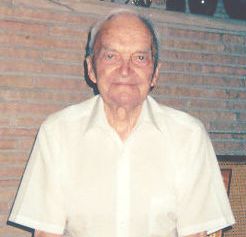
Dr. Walter Häussermann was born on March 2, 1914, in Künzelsau (Hohenlohe/Germany). He studied technical engineering in Stuttgart, where he finished his degree. Compulsory military service saw him in at the missile-testing site in Peenemünde from October 1939 until the end of 1942. He then wrote his dissertation, which he completed in the autumn of 1944, about an analogous device to test the navigation system of both V2 rockets and of submarines. In the wake of “Operation Paperclip” he was brought to the USA as member of Wernher von Braun’s team, where, as Director of the Astrionics Laboratory of the Marshall Space Flight Center, he was responsible for the development of the entire electrical system of the Saturn V lunar rocket. Germar Rudolf interviewed him early August 2002.
Q: In modern USA, the controversy of the moon landing is increasing daily. A growing number of skeptics insinuate that the whole deal was a hoax, initiated by the cold war. How do you respond to such allegations?
A: Well, I was present at all debriefings, making a detailed report every time. There was such a multitude of public employees that I cannot comprehend how such a hoax would be feasible. This is too preposterous even to discuss the matter earnestly.
Q: I understand that this seems ridiculous to a veteran witness, but those skeptics not present at that time will not accept such a pacifying answer. On the contrary: for them, this is just another supportive proof.
A: Well, today’s NASA personnel will know how to deal with it.
Q: One argument of the moon skeptics is for instance that films of the driving lunar Rover simply seem to have been made in slow motion on earth.
A: The Rover would not have been able to drive on earth. The laminated tires were constructed in such a way that they functioned as springs or shock absorbers. They were much too weak for earth gravitation. Such a vehicle would have had kind of four flat tires on earth. You can still marvel those tires at the museum. There, the moon Rover must be supported by a stand, otherwise it would collapse.
Q: However, this is no proof that such a car with such tires ever drove on the moon.
A: Oh, come on now! Listen, we were surprised what the astronauts said about their experience with the vehicle on the lunar surface. It seemed that they had to take great care so that the device would not overturn in curves, because of its meager weight and tenacity on the moon.
Q: Another seemingly convincing argument for the laymen is the impossibility to bring people through the Van Allen belt alive, albeit in a sound condition.
A: Radiation of the Van Allen belt is generally overestimated. A large percentage of it does not even get inside of a rocket. Furthermore, in the last forty years of expeditions into space, the highly sensitive electronic equipment has always passed the Belt. Without taking damage, you understand.
1. Mistrust against the authorities
Contrary to Germany, where the majority of the populace trusts their authorities in principle, the people of the United States are very critical and mistrusting, paranoid at times, of their government and its entire staff. There is practically no part of public life or of the historic past which is not subjected to analysis from more or less boisterous groups purporting insinuations or conspiracies against the population. One must not forget that the American majority descended from immigrants who left their native lands because of their distaste for either the government, the political, or the social structure. In fact the United States owes its existence to their revolution against the authorities at that time, in this case against the United Kingdom.
Skepticism concerning the technical feasibility of a manned flight to the moon is older than the Apollo Lunar Project. That America would realize such a program from scratch, an America not even capable of constructing a dependable missile system at the end of the fifties; all this seemed highly improbable. The lunar landing project itself was nothing more than a child of the Cold War. Had the United States not indulged in a technical competition with the Soviet Union, there would have been no such ambitious and, at first glance, seemingly ridiculous project. What sense did it make flying 380,000 kilometers just to land on some rock, kicking up dust?
It is no secret to most Americans today that their own government resorted to callous tricks in their struggle against the Soviets during the Cold War. One of the most traumatic events at that time was no doubt the assassination of John F. Kennedy, where the majority of Americans believe that it was orchestrated by their “system”.
Another factor endorsing the skepticism of contemporary America concerning the credibility of the lunar landing project was that nearly all responsible technicians and scientists of the Apollo Program were of German origin, brought to America by the “Operation Paperclip” after the Second World War. In their perception and in that of the contemporary, biased American youth, these German engineers and technicians were ‘Nazis’ and ‘war criminals’.
This fact alone neither propagated their trust in the moral integrity of the US Government, nor in the credibility of the entire Apollo project.
2. Skeptics gain public attention
On Thursday, February 15, 2001 (replay on March 19th), the American news network Fox TV transmitted a program entitled “Conspiracy Theory: Did We Land on the Moon?” Michael Pileggi, better known for his part in the X-Files, moderated the piece. For the duration of one hour, interviews were given to a number of people who alleged that the NASA Apollo lunar landings at the end of the sixties and beginning of the seventies were a fraud. Bill Kaysing who claimed to possess all possible proof for this hoax as well as pictures from the astronauts, technical details, physical proof, even declarations from the astronauts themselves, received particular attention. The report came to the conclusion that the entire Apollo landing program was faked in the desert of Nevada – naturally in the renowned “Area 51”, a testing site of the American Air Force which, since the Second World War, is the nucleus of the UFO conspiracy theoreticians.
Fox TV is not simply any television program; it’s one of the most successful and largest news networks of the United States. This shows the magnitude of public acceptance which these theories have encountered, namely that the six Apollo Moon Landings from 1969 until 1973 didn’t take place at all. Had the establishment ridiculed or ignored these skeptics in the past, yesteryear’s growing momentum of their strife has created a change of opinion today. Astronomers, astronauts, NASA experts and missile engineers are now forced not simply to belittle the arguments of the skeptics, but to respond openly, to take them seriously, and to refute them.[1]
The greatest part of this controversy between the two antagonists can be found on the Internet, where a growing number side either with the supporters or the opponents. The author of this article had first contact with arguments of the lunar landing hoax when Jürgen Graf asked him to regard a manuscript set for translation. Since I lived in Huntsville, Alabama, at that time – also known as Rocket City or Wernher von Braun City – nothing could be easier than to scrutinize the arguments of these conspiracy theoreticians. Did not the German missile team with Wernher von Braun work right here in Huntsville? Was this not home of all NASA experimental sites and didn’t veterans of the missile project live here as well? Isn’t America’s largest Space and Missile Museum located here too? A visit to this museum was not futile because a book, dealing with the arguments of the lunar landing conspiracy, was discovered.[2] Meanwhile, a video clip on the subject exists as well.[3]
3. Interesting Parallels
One of the first scientists to engage himself with moon landing doubters was Michael Shermer in his book Why People Believe Weird Things.[4] The same book also takes on holocaust revisionists in three chapters. It can come as no surprise that Shermer, who is well known by readers of the VffG,[5] rebukes revisionism as well as forged moon landings as “lunatic” ideas. According to Shermer, the hidden cause for holocaust revisionism and for moon landing criticism lies in ideological fanaticism and ignorance of what he calls the “convergence of evidence.”
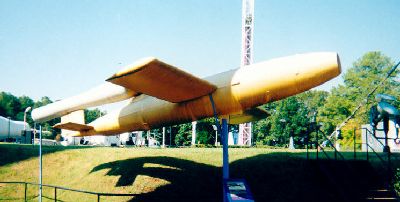
Mockup of a German WWII V1 Rocket at the Space and Rocket Museum in Huntsville, AL. There is probably no other place on earth where German engineering is more adored and honored than here.
As far as I’m concerned, the only thing holocaust revisionism and moon landing skepticism have in common is the fact that the majority (still) shake their heads in disbelief and regard them as crazy ideas. This is where all parallels end. Not one moon landing skeptic was ever socially isolated nor prosecuted, nor did one of the major television networks grant revisionism an hour-long debut of their arguments without contradiction.
Whereas it is the established side in the moon landing controversy that insists on the superiority of technical arguments, this situation is turned around when it comes to revisionism: here, the official side either doesn’t take notice or refuses acknowledgement of technical evidence, using legal and even illegal means to thwart them. Furthermore, anybody wanting or offering evidence supporting revisionism is socially isolated and persecuted. That’s why a comparison between revisionism and lunar landing criticism is far fetched; it’s like comparing black and white.
4. Theses and Antitheses
Thesis: One of the most popular and easily refuted argument against moon landings is the correct observation that all photos taken by the Apollo astronauts miss out on stars, even though the universe is totally black due to lack of a lunar atmosphere. This would prove that the background is not the universe but a studio forgery.
Antithesis: All pictures taken by the astronauts on the moon were shot during the daytime, in glaring sunlight. Because there is no atmosphere on the moon, sunlight is reflected here more intensely than on earth. Therefore, the astronaut’s cameras had to be adjusted so that the objects photographed would not be totally over-exposed. The aperture was at a minimum, the exposure time extremely short. There was not enough time for the dim light of the stars to leave a trace on the film. Should anybody take a photo on earth in the black of night using the same camera settings as the astronauts, the results would be equal: no stars.
Thesis: The descent engine from the lunar module should have removed all dust and debris in and around the landing site, creating a crater. However all pictures show no such crater, indicating the module didn’t land on its own, but was put in place by a crane.
Antithesis: At the very beginning of the planning phase, American scientists were indeed concerned that the propulsion from the lunar module might provoke a dust storm on the moon.[6] This concern, however, proved groundless. For the sake of clarity, a few calculations are necessary.
The lunar module of the Apollo Missions had a mass of about 14.5 tons.[7] Because the moon’s gravitational pull equals one-sixth of the earth’s, a mass of 14.5 tons has a weight on the moon like 2.4 tons on the earth’s surface. Thus, to guarantee a soft landing on the moon’s surface, the module must develop a thrust corresponding to the weight of 2.4 tons on earth (2,400 kp = 23,500 N). The diameter of the lunar module’s nozzle was 137 cm,[8] corresponding to an area of 1.47 m². Thus, the pressure from the exhaust gases correlate to 160 g per cm² (circa 1.6 N/cm²), corresponding to roughly 16% of the atmospheric pressure on the earth’s surface (1 bar = 100,000 N/m² = 10 N/cm²). This pressure is at most very weak.
Furthermore, one must consider that there is a vacuum on the moon’s surface; gases from the propulsion would expand very rapidly in all directions. Hence, when the exhaust gas contacted the lunar surface, its pressure was well under ten percent of the atmospheric pressure on earth. This would suffice to blow up dust, but not to create a large crater where all dust and debris would have been removed.
Thesis: Right next to the lunar module, one can see the imprint of the astronaut’s boots in the dust, further evidence that dust was not removed from the descent engine, as one should expect from an actual lunar landing. The lunar module itself should have been covered with the dust it whirled up.
Antithesis: Reference is made to the antithesis of the previous question, which proves that the thrust of the lunar nozzle is overestimated. One must note that whirling up dust on the moon has a completely different effect than on earth. While dust on earth would be carried through the atmosphere to settle in some remote area, dust on the moon strictly adheres to Newton’s law of gravity: it falls back to the surface in form of a parabolic curve. There is no whirling up of dust, as we know it on earth. Because of the relatively low exhaust gas pressure of the module’s nozzle, the disturbed dust would actually fall back to the surface in the immediate vicinity of the nozzle. It is indeed plausible that the layer of dust close to the nozzle was indeed thicker than before the landing. Thus, there can be little doubt that pictures of the module must portray imprints from the astronaut’s boots.
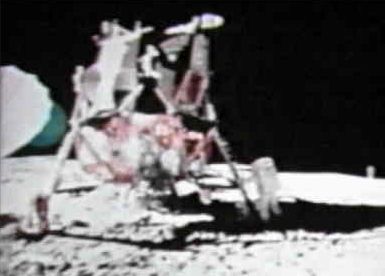
Fig. 1: Photo of the moon: fact or fiction?

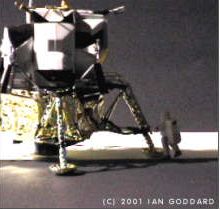
Fig. 2 & 3: Ian Goddard’s moon landing model with astronaut figurine on grey (left), in black (right) background.[9]
Thesis: Another argument also refers to the pictures taken by the astronauts on the moon. If, as suggested, these photos originated from the moon with no atmosphere which would have dispersed the sunlight, why don’t all objects cast a completely black shadow? If the sun is the only source of light, all shadows ought to be black.
Antithesis: Of course, the sun isn’t the only source of light on the moon! The lunar surface itself reflects an abundant amount of sunlight, as we can see on earth. As one notices on the photos taken by the astronauts on the moon, sunlight is reflected from the moon’s surface, being in itself an intensive source of light which illuminates all shadows of all objects on the moon. Ian Goddard has proven these effects on his website in a convincing demonstration, see Fig. 1 to 3.
Thesis: Another argument also refers to the shadows of the Apollo pictures. Should the sun have been the only source, all shadows ought to be parallel to each other. However, one can clearly see that not all of them are, which indicates falsification.
Antithesis: This argument is apparently void of all consequential thought. Had there been more than one source, then the objects must throw more than one shadow. This does not seem to be the case here. Another possibility would be that the source is relatively close to its object, so that shadows tend to disperse into the distance. This is not always the case. The problem lies in the lack of understanding about perspectives and projections of three-dimensional objects on two-dimensional plains. Aberrations are unavoidable. Shadows of objects will only appear parallel if the area upon which the shadows are thrown, are themselves even and if these shadows are regarded from a great distance, thereby minimizing perspective aberrations. See Figure 4 and 5.
Thesis: A few Apollo moon shots depict different foregrounds with identical backgrounds. NASA explains that the photos were taken at different sites. Then the background should have a different perspective, which is not the case here. This shows that the spots were not taken in front of a natural background, but in front of a static studio background. (Compare Fig. 6 & 7).
Antithesis: On earth, we’re used to seeing mountain ranges disappearing in the haze the farther away we get from them. A large part of human stereoscopic impression relies on this effect. That is why distant objects seem particularly close on a clear day, in contrast to a misty day. The moon has no atmosphere. To the human eye, a distant mountain range, actually being kilometers away, seems therefore quite close. Skeptics have all succumbed to this optical illusion, because the range in question is so distant that any perspective alterations are hard to recognize for the naked eye. Superimposing the two pictures would prove a slight deviation.[10] A film sequence of an Apollo moon landing illustrates the difficulties in judging distances and sizes of lunar objects. A piece of rock being a few meters large at a distance “grew” to a large bolder while closing in with the rover.[11]
Thesis: An Apollo-16-film sequence shows one astronaut on a hill, and another one shows two astronauts on the same hill. When the film was published, NASA stated that the two hills were four kilometers apart. It’s obvious that the two hills are identical and that NASA was lying.
Antithesis: The two sequences were actually taken three minutes apart at the same place. When the film was broadcast, NASA simply made a mistake, as affirmed by Eric Jones, publisher of NASA’s editorial: Apollo Lunar Surface Journal.[12]
Thesis: Because the astronauts moved about in the lunar module, thus continuously altering its center of gravity, it was impossible to steer, let alone land the module on the moon.
Antithesis: Steering an object propelled by thrust, whether ascending or descending, equals the balancing act of a rod with fingertips. (Helicopter pilots are very familiar with this phenomenon). The thrust must always be trimmed even if there is no alteration in the center of gravity. An unmanned missile also underlies continuous gravitational changes due to its continuous fuel consumption. The missiles’ success over the last decades contradicts this argument completely. Mobile astronauts (in a module) might aggravate the problem a bit, but balancing this is no problem and accomplished by a simple adjustment via the nozzles.
Thesis: A camera piloted by remote control, left behind on the lunar surface, filmed the end of the lunar mission. This sequence does not show exhaust gases from the nozzle of the module, therefore the film must be a fake.

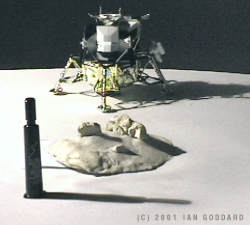
Fig. 5 (top) Model of converging shadows due to uneven area.[9]
Fig. 4 (left) Apollo photo with non-parallel shadows.[13]
Antithesis: It is important to note that the motor of the lunar Module was far smaller than those motors we’re used to seeing during the dramatic Apollo and Space Shuttle starts here on earth. In contrast to those rockets that start from earth, the kind of fuel employed on the lunar module produced no visible flame, smoke, or vapor.[14] Furthermore, the gases from the nozzle expanded so quickly that a flame in vacuum gets dispersed so quickly that it never achieves the brightness or density it has on earth.
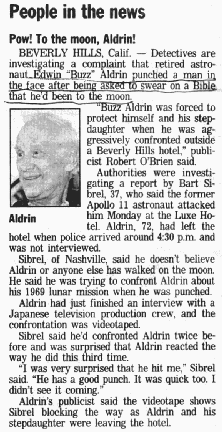
Astronaut Edwin Aldrin was molested so profusely by moon conspiracy aspirants that he lost his self-control and attacked one of them. America is the land of religious fanaticism and of poor general education which leads to the cancerous growth of pseudo-scientific theories, like the holocaust cult, creationism, and moon landing skepticism. (“Huntsville Times,” September 9, 2002, D5).
Thesis: Doubling the projection speed of a film showing astronauts driving their lunar rover gives the sequence an earth-bound character. Thus, these films must be fraudulent.
Antithesis: The films of the driving lunar Rover indeed prove that the pictures were taken on the moon and no place else. One must only regard the characteristic way the dust behaves which was whirled up by the rover’s laminated tires. Should this have happened in an atmosphere, dust would have been whirled up, like every vehicle on earth, driving through dusty area, produces a huge dust cloud behind itself. Moon dust, however, returns to the ground in a perfect parabolic curve, as did the dust whirled up by the moon rover. In order to falsify these photos in an expansive area, NASA would have had to build huge vacuum compounds. Such compounds never existed, neither yesterday nor today. This does therefore not only refute that argument of the “moon landing deniers” (I couldn’t resist), but it actually positively proves that moon landings were factual.
Thesis: When the astronauts set up the American flag, it waved. This is because the photos were taken on earth; the flag came in contact with an air stream. Flags don’t flutter in a vacuum. Further copies show a folding flag, evidence that there was wind in the studios.
Antithesis: Flags do flutter in a vacuum, especially after the flagpole was positioned, which was the case here as the astronauts straightened it up. Since a vacuum has no friction, which would decelerate the swaying or waving of a flag, a thus upset banner would continue moving even longer than in a tranquil atmosphere. Just because a banner folds up does not prove that it’s moving; a folded, a hanging curtain doesn’t prove room draft either.
It is customary in America to portray a banner fluttering in the wind. Therefore, the astronauts would set the flag so that it would produce folds, showing a picture dear to Americans. If claiming that the banner was moved by wind, then one must ask why the extremely light dust wasn’t moved just as well. Because the dust was not moved, this proves that the photographs were made in a tranquil area.[15]
Thesis: The lenses of the astronauts’ cameras had optical cross wires. Some photos portray objects apparently in front of these wires, which is impossible if the wires were actually etched into the camera’s lens. These photos must be forgeries (see fig. 8 & 9).
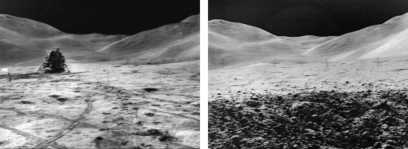
Fig. 6 & 7: The same background, but different foregrounds: at the left with the moon lander, at the right without it. However, if carefully analyzed, it turns out that the background is not identical, but has shifted slightly due to a different perspective (see position of a hill top).[9]
Antithesis: This argument implies that NASA added the cross wires onto the photos after their development in a more or less sloppy manner. Because cameras with cross wires existed for a long time, one would be inclined to question why NASA didn’t use such a camera in one of its alleged forgery studios instead of resorting to sloppy retouching. In actual fact, the areas where the cross wires seem to be missing are those where local overexposure had taken place, where glaring objects irradiated slight, dark objects in their immediate vicinity. This effect is fundamental knowledge in photography. See also Figure 10.
Thesis: One of the most frequent arguments against moon landings is that radiation from the Van Allen Belt and beyond, in space would have killed the astronauts within a few minutes.
Antithesis: The Van Allen Belt is a region surrounding earth whose magnetic field routes the electrically charged particles (electrons and protons) of the solar wind. A fraction of the solar wind can enter the earth only at the poles causing the so-called polar lights (aurora borealis). An unprotected human being would indeed be killed by radiation within the Van Allen Belt, should he be exposed for a given length of time. The Apollo rockets, however, passed the Van Allen Belt within one hour. Additionally, the overwhelming part of the solar wind cannot penetrate the rocket’s metal hull at all.[16] Had the particle radiation of the solar wind indeed such lethal effects, i.e. even after passing through steel of several millimeters, then one had to assume that any kind of sensitive electronic equipment on board of any rocket would also have been ruined by the Van Allen Belt. However, none of the many American, Russian, European, Japanese, or Chinese missions to the moon, to other planets, to comets or into deeper space ever failed because of damage to the highly sensitive electronic equipment on board caused by the Van Allen Belt.
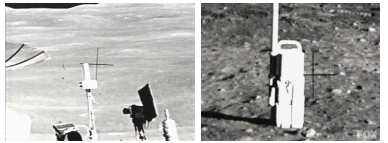
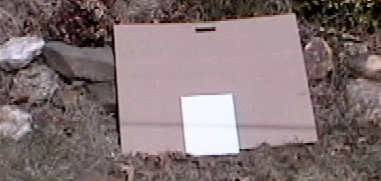
Fig. 8-10: Irradiation effect of glaring objects: Top: optical cross wires on the Apollo camera lenses disappear when overlaid by glaring white objects. Bottom: Shadow of a laundry line disappears on a white sheet of paper. [9]
5. Conclusions
Arguments brought forward by skeptics of the moon landings are altogether based particularly on ignorance of technical and scientific fact and can be refuted quite easily. It is a pleasure to note that experts and hobby astronomers do not refrain from addressing these arguments, but accept this challenge eagerly and discuss it publicly, and in most cases with the objectivity that this matter deserves.
Although I myself had an intensive discussion with a leading German rocket engineer, Wernher von Braun’s right hand (see inset), I have refrained from using him as witness, because a scientist must not employ such weak proof at all. Should a few retired gentlemen reminiscing on their past be the only proof for the fact of the lunar landing missions, NASA’s case would be weak indeed.
Research of scientific literature on astronomy will yield greater results. I did find, for example, a fairly recent article which demonstrates how an exact measurement of the distance between moon and earth can be made:[17] three of the six Apollo missions to the moon left a laser mirror there exactly for this purpose as well as for the measurement of moonquakes and other irregular movements of the moon’s surface. How can scientists today take such measurements with a strong laser beam, if Apollo missions did not land on the moon?
Further Reading and Watching:
- Nvidia Debunks Conspiracy Theories About Moon Landing (Sept. 23, 2014)
- Was The Moon Landing A HOAX? (Oct. 12, 2016)
- The Lunar Reconnaissance Orbiter Mission explained:
- Recent photos of the Apollo Landing Sites:
- Appolo 11: “A Stark Beauty All Its Own” (NASA, Arizona State University, March 07, 2012)
- Apollo 12: “Apollo 12 Landing Site” (NASA release; November 4, 2009); “Pinpoint Landing on the Ocean of Storms” (NASA, Arizona State University, March 6, 2012); YouTube video: “Lunar Reconnaissance Orbiter Camera Explores the Apollo 12 Landing Site” (NASA, March 6, 2012):
- Apollo 13: 3rd stage rocket booster: “Rocket impacts recorded by the Apollo seismic network” (NASA, Arizona State University, March 22, 2010)
- Apollo 14: “NASA – LRO Could Have Given Apollo 14 Crew Another Majestic View” (February 4, 2011); 3rd stage rocket booster impact: “Apollo 14 S-IVB Impact Crater” (NASA, Arizona State University, March 22, 2010)
- Apollo 15: “Follow the Tracks” (NASA, Arizona State University, March 5, 2012); including the tracks of the lunar rover, and the rover itself!
- Apollo 16: 3rd stage rocket booster: “Found! Apollo 16 S-IVB Impact Crater” (NASA, Arizona State University, Dec. 2, 2015)
- Apollo 17: “LRO Briefing: Latest Images of Apollo Landing Sites” (NASA, September 6, 2011); Video showing Apollo 17 landing site:
- Fake Stanley Kubrick Interview:
- Dan Evon, “Lie Me to the Moon”, Snopes.com, Dec. 11, 2015
- YouTube video of the fake footage of actor “Tom” being prompted to say certain things a certain way (starting at 12 min 45 sec, with the name “Tom” being used at 14:10) [that video was removed, I am afraid to say]:
- Publications on analysis of lunar data recorded by devices left by the astronauts during various Apollo missions to the moon (Apollo Lunar Surface Experiments Package) (results as of Dec 12, 2015):
- Lunar seismic data analysis: Scholar Google with 1180 results
- Lunar laser data analysis: Scholar Google with 191 results
- Lunar Ejecta and Meteorites: Scholar Google with 152 results
- Charged Particle Lunar Environment Experiment: Scholar Google with 132 results
- Lunar Surface Gravimeter: Scholar Google with 163 results
- …and many more (see here for details of all the experiments deployed)
Notes
First published in German in Vierteljahreshefte für freie Geschichtsforschung 6(4) (2002), pp. 449-455. Translated by Dr. Harald Hortig.
| [1] | Recently, NASA went through a real PR disaster when it cancelled an author contract it had signed with an expert to refute all arguments against the moon landing. The author was so upset about this that he stated that the arrogant NASA deserved the skepticism it encounters: Süddeutsche Zeitung, Nov. 12, 2002, www.sueddeutsche.de/index.php?url=/wissenschaft/mehrwissen/56965&datei=index.php |
| [2] | Philip C. Plait, Bad Astronomy: Misconceptions and Misuses Revealed, from Astrology to the Moon Landing »Hoax«, 288 p., John Wiley & Sons; see also an interview with the author, USA Today, Feb. 16, 2001. |
| [3] | Aron Ranen, Moonhoax: Did we go? A documentary film; www.moonhoax.com) |
| [4] | Freeman, New York 1997. |
| [5] | Cf. his article “Versuche der Widerlegung revisionistischer Thesen”, in VffG 3(2) (1999), pp. 173-175. |
| [6] | Cf. www.astronautix.com/craft/lmdlsion.htm |
| [7] | www.astronautix.com/articles/apoaries.htm |
| [8] | www.friends-partners.org/mwade/craft/lmdlsion.htm |
| [9] | www.badastronomy.com/bad/tv/iangoddard/moon01.htm |
| [10] | www.hypnoide.com/moon |
| [11] | www.hq.nasa.gov/office/pao/History/alsj/a16/a16v.1673855.ram |
| [12] | Cf. www.hq.nasa.gov/alsj/a16/a16.sta4.html; www.hq.nasa.gov/alsj/a16/a16v.1444638.ram; www.hq.nasa.gov/alsj/a16/a16v.1445240.ram |
| [13] | www.apollo-hoax.co.uk/strangeshadows.html |
| [14] | Hydrazine and di-nitrogen-tretroxide react forming nitrogen and hydrogen; www.abc.net.au/science/moon/rocket.htm |
| [15] | www.hq.nasa.gov/alsj/a11/as11-40-5874.jpg; spaceflight.nasa.gov/mars/reference/flag/flag.html |
| [16] | Particle radiation penetrates only a few micrometers into solid materials; regarding the radiation the astronauts were exposed to, cf. http://spider.ipac.caltech.edu/staff/waw/mad/mad19.html; http://lsda.jsc.nasa.gov/books/apollo/S2ch3.htm |
| [17] | E. Samain et al., “Millimetric Lunar Laser Ranging at OCA”, Astron. Astrophys. Suppl. Ser. 130, pp. 235-244; www.edpsciences.com/articles/astro/full/1998/11/ds1427/ds1427.html |
Bibliographic information about this document: The Revisionist 1(1) (2003), pp. 75-81
Other contributors to this document:
- Dr. Harald Hortig: translation
Editor’s comments: First published in German in "Vierteljahreshefte für freie Geschichtsforschung," 6(4) (2002), pp. 449-455
